![]()
![]()
![]()
Use LEFT and RIGHT arrow keys to navigate between flashcards;
Use UP and DOWN arrow keys to flip the card;
H to show hint;
A reads text to speech;
97 Cards in this Set
- Front
- Back
|
Koch Triangle |

|
|
|
BBRT characteristics |
1) structurelly abnormal hearts 2) AV Dissociation 3) H before the onset of QRS 4) HH changes predict VV changes 5) needs ablation of the right bundle 6) HV during tachy ≥ SR 7) typical BBRVT has LBBB |
|
|
Normal AH and HV intervals |
AH 50-140 HV 35- 55 |
|
|
VA time during tachycardia 1) ≤70 ms 2) >70 ms 3) VA> AV, aka long RP |
1) ≤70 ms. = tAVNRT DD septal AT 2) >70 ms. = aAVNRT, AVRT, AT 3) VA> AV, aka long RP aAVNRT, AVRT (slow AP) , AT |
|
|
Significance of CL and VA time changes associated with BBB occurrence during SVT |
CL is not specific VA ≥ 35 ms = freewall AP ipsi to BBB VA < 35ms or no change= septal AP |
|
|
VAAV response AVVA response |
VAAV response = ATAVVA response = VT |
|
|
During Burst atrial Pacing, termination in V excludes |
Atrial Tachycardia |
|
|
Jump = ... ms |
Jump = 50 ms |
|
|
PPI- TCL =30ms means that the entrainment site is ... |
In the tachycardia circuit |
|
|
SA is VOP to A VA is VA during tachycardia SA - VA < 85 means .... SA - VA > 85 means .... |
SA - VA < 85 AVRT SA - VA > 85 AVNRT |
|
|
HH changes predict AA? |
Yes= AVNRT, AVRT (exclude AT) No = AVNRT, AVRT, AT |
|
|
Entrainment during ventricular tachycardia Algorithm |
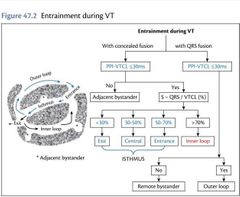
|
|
|
Diagnostic Maneuvers for SVT, Veenhuyzeen |
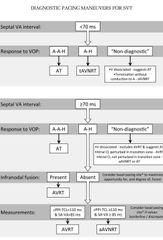
|
|
|
VA time increase > 30ms with BBB |
Orthodromic AVRT with AP ipsilateral to the BBB free wall |
|
|
Spontaneous termination of tachycardia with a 1:1 conduction with an A |
Excludes AT |
|
|
Atrial activation sequence: 1) High to low 2) Concentric 3) eccentric |
1) High to low = AT 2) Concentric = AT, AVNRT, AVRT 3) eccentric = AT or AVRT |
|
|
AVNRT with earlieast A at the: 1) superior septum = His = 2) inferior septum = CS = |
1) superior septum = His = typical fast pathway. 2) inferior septum = CS = atypical= slow pathway |
|
|
∆HA= (HA)p - (HA)T ∆HA> 15ms= |
∆HA> 15ms= lower common pathway |
|
|
How to differentiate between a jump in dual AV node physiology and AVNRT? |
After dual it wenckbachs, after AVNRT 1:1 conduction continues |
|
|
A condition where a PVC advances/ resets the atria without advancing the His and causes fusion |
Only AVRT |
|
|
In atrial fibrillation .... block is almost always associated with a .... block |
An exit block is almost always associated with an entrance block |
|
|
How to know if the PVC is His refractory? |
1) QRS shows fusion 2) pacing stimulus occurs after a discernible antegrade His 3) if PVC occurs no more than 35-55 ms earlier than the anticipated antegrade His |
|
|
What to do when A and V signals are superimposed?
|
PVC to the para hisian region; advances the local V but not the A In the absence of the AP |
|
|
AV Dissociation excludes ... |
AVRT |
|
|
DD of narrow complex tachycardia with AV dissociation |
1) JET 2) Tachycardia from His Purkinje system 3) AVNRT with block in the upper common pathway 4) nodofasicular or nodoventricular pathway |
|
|
A purkinje potential is ... |
Is a sharp potential occuring < 15ms before the V electrogram |
|
|
Termination of the tachycardia with a His refractory PVC without conducting to the atria |
AVRT |
|
|
Antegrade His activation |
Proximal to distal |
|
|
Capture of PV sleeves during AF can only happen if |
If the encircled area is completely isolated ( entry block) |
|
|
Mahaiam characteristics Nodo fascicular AP |

1) Resetting of the tachycardia with a PAC with RV apex preceeding surface QRS and the V signal on His 2) little or no preexcitation at rest 3) isoelectric s- sigma internal at maximum preexcitation. 4) LBBB 5) retrograde His activation and still 6) His before V 7) Mahaiam potential with late V at the tricuspid annulus
|
|
|
Doublenfire Tachycardia |
1) Non reenterant AV nodal Tachycardia 2) uses slow and fast pathways as antegrade limbs 3) resulting in long short long HH intervals |
|
|
PJRT characteristics |
Perman. Junct. Recip. Tachz 1) orthodromic AVRT associated with a concealed slow posteroseptal AP 2) incessant with -ve P waves in inferior leads 3) long RP 4) children/ infants DD is aAVNRT fast slow, where AA leads the VV |
|
|
An epicardial structure running between LSPV and LAA |
Vein of Marshall |
|
|
During atrial pacing: ∆VA = VA return cycle- VA Tachycardia > 14ms |
Confirms AT In AVRT and AVNRT should be < 14 ms, almost fixed |
|
|
A structure adjacent to the RSPV and a source of far field signals |
The SVC |
|
|
Clinical significance of the heavy trabeculations and low hematic flow in the RV basal free wall |
Decresed blood cooling leading to high temperatures during ablation |
|
|
PVC origin in V1 from the ourflow tract |
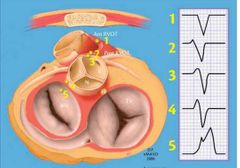
|
|
|
DD of a His buried in V despite its presence in SR |
Antidromic AVRT or VT |
|
|
Mitral Valve PVC |
Completely positive or M in V1 |
|
|
Imporatnt in parahisian pacing .... (To determine the presence of an AP as well) |
The atrial activation sequence in the two beats |
|
|
During tachycardia, resetting of A and fusion only occurs in |
AVRT |
|
|
AV Block in the setting of normal QRS und PQ suggests a .... Block |
Suggests an intrahisian block |
|
|
Tachy related LBBB is due to ... Block Brady related LBBB is due to ... Block |
Tachy related LBBB is due to phase 3 Block, while Brady related LBBB is due to phase 4 Block |
|
|
HV interval in Fascicular VT is |
Short or even negative, 5 bis 30 ms nach QRS |
|
|
Atriofascicular Pathways have ... Morphology |
LBBB |
|
|
Difference in entrainment in Junctional tachycardia and AVNRT |
Junctional Tachycardia displays AHHA response |
|
|
Characteristics of a PVC originating from the right moderator band |
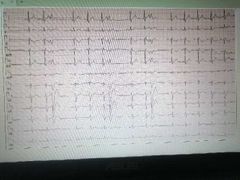
1) LBBB in V1 2) late precordial transition, V5 or later 3) Axis site is superior and leftward |
|
|
PVC originating from the posteromedial PM |
1) RBBB 2) superior Axis |
|
|
PVC originating from the anterolateral PM |
1) RBBB 2) right inferior axis |
|
|
Transitions in outflow tract PVCs |
1) V4 or later then right 2) V2 or ealier then Left 3) V3 can septal RVOT or RCC |
|
|
Activation time= Depolarizarion in EGM |
Unipolar: steepest negative downstroke
Bipolar: most negative/ positive point |
|
|
Activation recovery interval= repolarization |
Unipolar: steepest positive deflection |
|
|
Ashman's phenomenon |
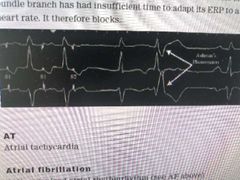
When Long RR followed by short RR, the short RR QRS has RBBB. = Long shortening the bundle branches |
|
|
PV Entrance Vs. PV Exit block in AF |
Entrance: no conduction from LA to PV Exit: no conduction from PV to LA Independent PV activity that doesn't exit the vein is a sign of a block |
|
|
Why is AVN conduction slow? |
Due to heterogenity and number of connexins: Connexin 45 mainly and some 40 near His |
|
|
Iv Medications in preexcited AF |
Procainamid/ Ibitulide IIa |
|
|
When not to use Amiodaron? |
1- LQTs 2- preexcited AF |
|
|
AAD whose effect is more pronounced in treadmill test? what effect? which AAD won´t affect normal tissues? |
Ic: Propafenone (QRS prolongation) Use dependance >25% replace the medications. Ib: Lidocain (has also use dep. block). |
|
|
ẞ- blocker that prolongs QTc? |
Sotalol |
|
|
Which AAD to use in VT storm in Brugada? |
Quinidine |
|
|
Brugada criteria |
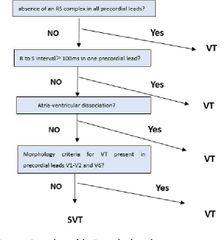
|
|
|
VT vs. SVT in lbbb and rbbb |
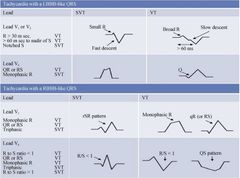
|
|
|
Normal SNRT, CSNRT, TRT, SACT |
SNRT < 1500 ms, CSNRT< 550ms total recovery time < 5 S SACT 50->115ms |
|
|
Normalization of a QRS complex with a His extrasystole is a proof that |
The abnormal QRS complex was due to pre- excitation |
|
|
Parahisian pacing with no AP |
>50ms difference |
|
|
Pre- excitation index |
The prematurity of the latest RV apex PVC able to advance the atrium TCL- Coupling interval of the PVC >75ms = left lateral <45ms = septal Intermediate = right free wall CAVE PEI > 120 ms is usually NOT His refractory |
|
|
Phase 4 AV Block |
Responsible for parox. AVB. Tachy termination or PVC or long PP: causes slow spont. depolrization of the diseased His Pur system HSM indication |
|
|
Site of WPW from earliest retrograde A |
LL = distal CS HRA = rr. Free wall PS = prox. CS AS = His Cath |
|
|
SQTs |
Gain of function, K channel disease Rx: we use K ch. Blockers such as Defitilide and Quinidin |
|
|
Genetic Basis of BrS |
Most commonly Na ch. loss of function, followed by loss of function of Ca. Ch. This loss of function in Na is the opposite of LQT3 Leaky Na ch. |
|
|
Rx of Brs |
Quinidine, RVOT epicardial ablation, fever must be lowered, Brugada drugs If sympt: ICD |
|
|
CPVT Pathology Dx Rx |
1) Calcium channels leaky Ryanodin receptors RYR2 leading to increased diastolic calcium 60% of CPVTs. arrhythmia is due to DADs 2) Stress ECG with PVCs between Hr 110-130 that disappears during recovery. Or less commonly bidirectional VT like Digoxin toxicity 3) Nadolol and fleccanid and LCSD Never Metoprolol, also not in Brs or LQTs 4) ICD when s/p cardiac arrest |
|
|
Andersen–Tawil syndrome |

LQTs 7, U after an isoelectric line Low set ears, smaller lower jaw Hypokalemic periodic paralysis |
|
|
Pompe Disease |
Glycogen storage disease, HCM, hypotonia, respiratory distress, muscle weakness, feeding difficulties, and failure to thrive, AR. Hepatomegaly and macroglossia |
|
|
Danon Disease |
Glycogen storage disease, X- linked, HCM, Heart failure, wpw, embolic strokes, skeletal muscle weakness, and intellectual disability (LAMP 2) and ophthalmological manifestations. |
|
|
PRKAG2 |
AMPK mutation, HCM and wpw, CHB, AF glycogen storage disease |
|
|
Fabry disease |
lysosomal storage diseases affecting the synthesis of sphingolipids (alpha-galactosidase), x linked, CKD, AV Block, SCD, VT, corneal clouding but not blindness, Tinnitus |
|
|
Friedreich's ataxia |
impaired speech, ataxia, HCM, deafness and blindness, DM, scoliosis |
|
|
FHL1 |
4 n half LIM domain 1, isolated x- linked HCM |
|
|
MELAS |
Mitochondrial Encephalomyopathy, Lactic Acidosis, and Stroke-like episodes syndrome HCM. |
|
|
MERRF Syndrome |
mitochondrial disease, myoclonus epilepsy with ragged-red fibers. ataxia, dementia, optic atrophy, hearing loss |
|
|
Normal QTc in men and women |
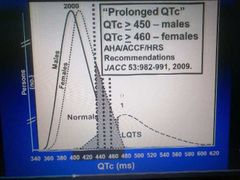
|
|
|
Noonan's Syd. |
Low set ears, webbing of shoulders, HCM, VSD, hearing deficits |
|
|
QTs |
LQT1wide based T loss K LQT2 notched T loss K LQT3 normal T after a long isoelectric segment gain Na In II and V5 |
|
|
Leopard Syndrome |
Lentigines, BBB, Ocular hypertelorism, pulmonary stenosis, abnormal genitalia and retarded growth, sensory neural deafness. AD |
|
|
AAD effective in ischemic zones and VT due to flecainid |
Lidocain: produces inactivated state block |
|
|
A side effect of Ivabradine. Does Ivabradine cause cardiac arrest? |
visual signs and symptoms Ivabradine causes no cardiac arrest, it lowers the HR leaving the ß-adrenergic stimulation effect intact. |
|
|
Arruda´s algorithm |
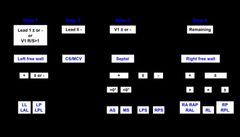
|
|
|
Type I exit block |
gradual shortening of the PP or RR interval with eventual failure to record a P or R wave. The resulting pause (< the sum of two CL) is typical of Wenckebach periodicity. |
|
|
Type II exit block |
the pause that is multiple of basic cycle length |
|
|
The most common cause of DAD |
Digitoxin: inhibits the sodium/potassium pump and leads to increase in intracellular calcium. DAD also occurs after reperfusion DAD coincides with the U wave DAD occur due to Ca overload |
|
|
EAD causes |
IcaL is the primary current responsible current, EAD occurs in LQTs, bradycardia, follows short long short it causes TdP |
|
|
Kearns–Sayre syndrome (KSS) |
mitochondrial disease> CHB, blindness, deafness, CKD, mental retardation |
|
|
Idiopathic fascicular VT |
RBBB, LAD, verapamil sensitive (post fasc 90%), narrow complex, structurally normal heart. |
|
|
Upon cessation of the overdrive pacing, tachy continues and the VA of the return cycle difference from VA of tachy > 14 ms is suggestive of... |
AT |
|
|
2:1 conduction during AVNRT might be due to ... Or.... |
Block in LCP in atypical AVNRT or infrahisian block in typical AVNRT |
|
|
PVC localization algorithm V1: qR: V1: w: |
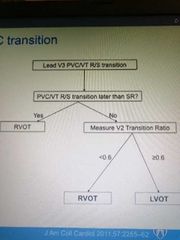
PVC localization algorithmV1: qR: AMCV1: w: LCC/ RCC |

